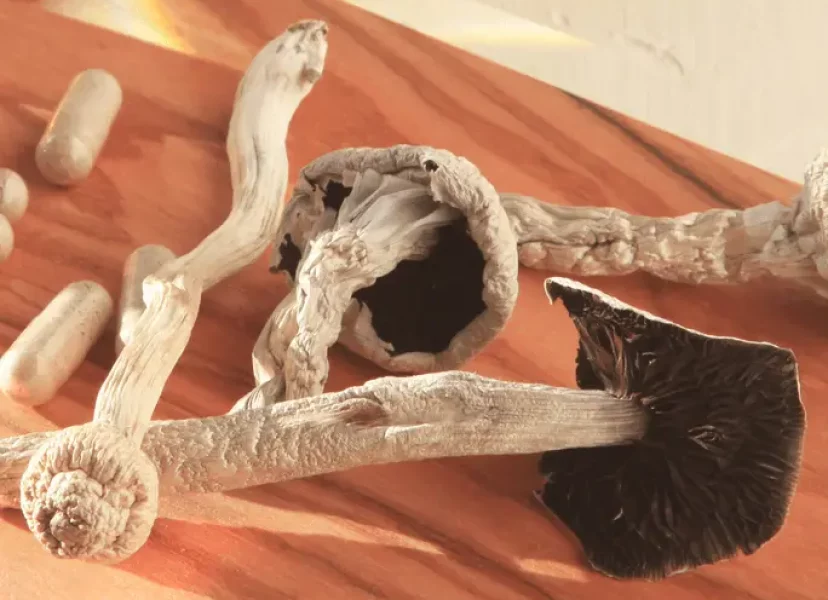In this defining era of mind and consciousness exploration, research has led to remarkable findings on the use of psychedelic medicines for treatment of a variety of psychological disorders and somatic ailments. Some previous and ongoing studies surround their efficacy in significantly reducing symptoms associated with depression, anxiety, and PTSD.
Could successful management or treatment of dementia be one of the next big findings of ongoing clinical trials? Johns Hopkins University is currently running a study on psilocybin as a potential aid for depression in people with early Alzheimer’s disease. We’re looking forward to the future development of psychedelic research as it pertains to regenerative medicine.
This meta-analysis will discuss the influence of psychedelics on neural tissue homeostasis by reviewing research data, with an emphasis on neuroimmunology. We’ll be synthesizing our current understanding on the neurology of dementia disorders with recent research on psychedelic-induced central nervous system effects.
Our goal is to estimate the therapeutic effects of psychedelics on dementia-affected brains to evaluate their potential for decelerating or even reversing neurodegeneration. We hypothesize that psychedelics can be an effective therapeutic option for the treatment of neurodegenerative diseases due to their role in stabilizing neural tissue function.
What is Dementia?
Dementia is an umbrella term for diseases that result from a loss of cognitive functioning. Some conditions include Alzheimer’s disease (AD), Parkinson’s disease dementia (PDD), Huntington’s disease dementia (HDD), and vascular dementia.
Typical symptoms of dementia involve the loss of memory, language, judgment, and thinking abilities, with changes to mood and overall personality. These conditions are progressive and though they’re most common in people over the age of 65, initial symptoms may begin to develop as early as age 30.
Dementia disorders are highly characterized by significant brain entropy reduction (BEN) throughout the aging process, where BEN is normally found to experience significantly less reductions with age (Ze Wang, 2020). Studies have found that psychedelic drugs like LSD offer potent mechanisms for increasing neuroplasticity and reducing aging-related entropy in the prefrontal cortex (Savino & Nichols, 2022).
Studies have found psychedelic-induced neurogenesis (the birth of new neurons) to be a common occurrence within the hippocampus (the brain structure associated with learning and memory), in a dose-dependent matter (Briony Catlow et al., 2016). Their proven role in stimulating synaptic plasticity has interested scientists due to their potential for treating neurodegenerative diseases.
The Pathology of Dementia
Oxidative Stress
One of the most common biomarkers of neurodegenerative diseases is oxidative cell damage. Imbalances amongst free radicals, reactive nitrogen species (RNS), reactive oxygen species (ROS), and reactive nitrogen species (RNS) are large contributors to this damage.
Antioxidants and antioxidative proteins like thioredoxin peroxidases (TRXPs), superoxide dismutases (SOD), and glutathione peroxidases (GPXs) also play a role in oxidative stress. Normally, balance between reactive species (redox homeostasis) helps to modulate crucial cellular processes like apoptosis, phagocytosis, and cellular signaling. However, people with Alzheimer’s and Parkinson’s experience disruption of redox homeostasis.
Reactive molecules can cause injury to mitochondria, DNA, and cellular membrane when cells cannot offset surpluses of them. This persistent damage gradually results in the degeneration of organs and tissues.
Blood-Brain Barrier Breakdown
The blood-brain barrier (BBB) is a selectively-permeable filtering mechanism that creates a border of cells preventing macromolecules and circulating toxins from entering the brain via bloodstream. BBB breakdown is present in Alzheimer’s and vascular dementia patients, and can occur due to extended subjection to oxidative stress and/or immune cell activity.
In some cases, microglia, immune cells of the BBB, release inflammatory signaling molecules, or cytokines. When they’re acting through IL-1β on the Sonic Hedgehog gene (SHH), these cytokines can reduce activity of tight junction (TJ) proteins in astrocytes (blood flow-regulating glial cells) and lead to leakage in the BBB (Yue Wang et al., 2014).
This downregulation disproportionately increases activation of immune cells and intensifies the secretion of proteins that stimulate cellular locomotion and promote inflammation. IL-1β secretion by microglia is also triggered by cytokines that are proinflammatory.
Endoplasmic Reticulum Stress (ERS)
Endoplasmic reticulum stress causes the upregulation of Sigma-1 expression. It also regulates the activity of proteins found in mitochondria-associated membranes, such as ATF6. ERS induces cellular apoptosis, or programmed cell death (Eva Szegezdi et al., 2006). ERS is found to be present in Alzheimers disease, Huntington’s, and Parkinson’s (Neil T. Sprenkle et al., 2017).
Dopamine & Glutamate
Parkinson’s disease (PD) is heavily characterized by the progressive loss of nigrostriatal dopaminergic neurons (DA cells) in the substantia nigra region of the brain. In healthy people, DA degeneration occurs very slowly throughout the aging process. However, a 50% rapid DA cell degeneration occurs in 2-5% of the population and results in the motivational and affective deficits in PD (G Drui., 2013).
Dyskinesia, the impairment of voluntary movement present in PD, is caused by degeneration of dopaminergic neurons which result in glutamatergic overstimulation (Javier Pagonabarraga et al., 2021). Therefore, a drug that modulates glutamate can produce a chain reaction that counteracts dopaminergic neuron loss and thus reduces or eliminates the presence of dyskinesia.
Psychedelics on Dementia-Afflicted Brains
As we know, an abnormal amount of oxidative stress is frequently noted in the pathology of dementia disorders like Parkinson’s and Alzheimer’s. Ayahuasca, a psychedelic brew native to the Amazon region, contains harmine and harmaline. Both are monoamine oxidase inhibitors (MAOIs) with antioxidant properties.
A 2017 study conducted by Morales-Garcia et al., used neural progenitor cells from adult mice to study the alkaloids found in ayahuasca. They found that the MAOIs in ayahuasca are able to activate neural progenitor cell migration and gliogenesis. This indicates that ayahuasca may combat oxidative stress and promote redox homeostasis through its antioxidant properties and the production of new neuronal and glial cells that replace those damaged due to disease.
8-OH-DPAT is a research chemical that was developed in the 1980s to study the 5-HT1A receptors. It’s a 5-HT1A agonist, meaning it activates 5-HT1A receptors, just like LSD and DMT. A 2016 study by Myazaki & Asanuma found that 8-OH-DPAT prompts expression of metallothionein-1/-2 (MT-1/-2) and Nfr2, which function as antioxidants. These findings suggest that LSD and DMT may reduce oxidative stress by triggering MT-1/-2 and Nfr2 expression through stimulation of 5-HT1A receptors.
Psilocin (the active metabolite of psilocybin), DMT, and mescaline can bind to trace amine-associated receptors (TAARs). Being that TAAR1 (a neurotransmission regulator) is incited by serotonin, glutamine, and dopamine, researchers Alexandra Alvarsson et al., set out to study its role in Parkinson’s disease.
This 2015 study administered RO5166017, a TAAR1 agonist drug like DMT and LSD, to TAAR1 knockout-mice (mice with inactivated TAARs) who’d been administered 6-OHDA (a neurotoxin that models Parkinson’s in rats). This was done to determine modulation of dopaminergic markers by their response to amino acid precursor, Levodopa (L-DOPA).
The study found that RO5166017 counteracted dyskinesia by preventing the release of corticostriatal glutamate. In PD patients, excessive glutamate concentration is induced by degeneration of dopaminergic neurons and is the cause of dyskinesia by basal ganglia and substantia nigra overstimulation.
These results indicate that TAAR1 agonists like DMT, psilocybin mushrooms, and LSD, may be a novel approach for counteracting dyskinesia and hyperactivity of glutamate in PD patients by preventing the degeneration of dopaminergic neurons via modulation of pre- and post-synaptic corticostriatal glutamate.
In a 2016 in vitro study by Attila Szabo at al., N,N-dimethyltryptamine (DMT) was found to stimulate dendritic cells, causing a flattening of IL-1β expression via activation of Sigma-1 receptors. In a 2020 in vivo study, Sandor Nardai and colleagues administered N,N-DMT to rats. Using mRNA and protein expression measures, they also found a significant downregulation of IL-1B.
These studies suggest that DMT may effectively prevent and/or halt blood-brain barrier breakdown by suppressing IL-1B secretion and reducing peripheral inflammation.
A 2018 study conducted by Thomas W. Flanagan and Charles D. Nichols used (R)-2,5-dimethoxy-4-iodoamphetamine, a 5-HT2A receptor agonist, to study the effects of serotonin receptor agonists on inflammation, in cellular and animal models. The study revealed that 5-HT2A receptor agonists treat inflammation by regulating inflammatory pathways. This suggests that 5-HT2A receptor agonists like LSD, psilocybin mushrooms, and mescaline may be potent anti-inflammatory agents.
A 2016 study by Tianfang Jiang and colleagues found that Sigma-1 receptor stimulation may prevent apoptosis induced by endoplasmic reticulum stress. Amazingly, the psychedelic drug, DMT (Dimethyltryptamine), targets the Sigma-1 receptor. This means that DMT may prevent hypoxia-induced cellular apoptosis in PD by stabilizing Bax and Bcl-2 presence in granulosa cells and balancing C/EBP, ATF4, ATF6 protein via activation of Sigma-1 receptors.
Another 2016 study study led by Attila Szabo and colleagues set out to test their hypothesis that DMT, a hallucinogen that is already present in mammalian brains, serves as a neuroprotective agent by mitigating ischemia (insufficient blood flow for proper oxygenation) and thus counteracting hypoxic stress.
Researchers used in vitro human cortical neurons to test their hypothesis. They found that DMT significantly increases the survival of pluripotent stem cells, monocyte-derived macrophages, and dendritic cells by activation of the Sigma-1 receptor. They also found that DMT reduces the expression of the hypoxia-inducible factor 1 (HIF-1), further confirming the potential role of DMT in ameliorating cellular stress caused by hypoxia.
These findings support the hypothesis that DMT can mitigate hypoxia-induced intercellular stress by decreasing expression of HIF-1 and increasing cell survival rates via Sigma-1 activation receptors.
Discussion
The information we’ve reviewed today offers a promising, novel approach for the treatment of neurodegenerative conditions like Alzheimer’s disease, Parkinson’s disease dementia, Huntington’s disease dementia, and vascular dementia.
However, while current research into the effects of psychedelics on neurodegenerative diseases such as dementia shows promising directions, it is crucial to underline that conclusive evidence remains sparse at this stage.
Nonetheless, the ongoing studies being conducted by institutions like Johns Hopkins University offer hope and anticipation for future discoveries that could significantly impact the field of regenerative medicine and the treatment of dementia.
The role of psychedelics in combating oxidative stress by promoting redox homeostasis, decreasing expression of HIF-1, stabilizing Bax and Bcl-2 presence in granulosa cells and balancing C/EBP, ATF4, ATF6 protein, is very compelling.
Additionally, their ability to ameliorate dyskinesia by regulating hyperactivity of glutamate, as well as their capacity to disrupt blood-brain barrier breakdown by suppressing IL-1B secretion and reducing peripheral inflammation, support our hypothesis that psychedelics may be an effective therapeutic option for treatment of neurodegenerative diseases due to their role in stabilizing neural tissue function.
We hope that this study will serve future research surrounding the potential role of psychedelics in treating early-stage dementia on both the micro and macro-dose levels.
Final Thoughts
Here at Psychedelic Passage we offer a carefully curated network of highly experienced psychedelic facilitators that are eager to assist you and your loved ones on your healing journey.
We believe that therapeutic psychedelic experiences should be treated with the utmost respect, valuing the sacredness of these medicines and encouraging your full autonomy every step of the way. If you’d like to get connected with our network of specialists, we empower you to book a consultation with us.
We’re here to be a resource to you. Traversing these grounds can be tricky, but it doesn’t have to be. For a wide array of informative articles like this one, head on over to our blog page. That’s all for now, friends. Safe journeying!



